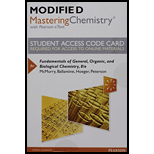
Interpretation:
The sequence in the template strand has to be predicted.
Concept Introduction:
Composition of
Base pairing in DNA: The two strands of the DNA double helix run in the opposite directions: one in 5’ to 3’ direction and other from 3’ to 5’ direction (complementary strand). The hydrogen bonding between two strands enhances the stability of the DNA; where the alignment of hydrophobic nitrogenous bases in the interior and hydrophilic phosphate and sugar groups on the exterior, is present that enhance the stability too. Adenine and thymine gives a pair forming two hydrogen bonds and cytosine and guanine gives rise to another pair forming three hydrogen bonds.
Replication of DNA: The process by which copies of DNA are made when a cell divides.
Illustrated relationships are:
DNA informational strand: 5’ ATG CCA GTA GGC CAC TTG TCA 3’
DNA Template strand: 3’ TAC GGT CAT CCG GTG AAC AGT 5’
Want to see the full answer?
Check out a sample textbook solution
Chapter 26 Solutions
Modified Mastering Chemistry With Pearson Etext -- Standalone Access Card -- For Fundamentals Of General, Organic, And Biological Chemistry (8th Edition)
- What are the base-pairing rules for DNA? a. A-G, T-C c. A-T, G-C b. A-C, T-G d. A-A, G-G, C-C, T-Tarrow_forwardChemical analysis shows that a nucleic acid sample contains A, U, C, and G. Is this DNA or RNA? Why?arrow_forwardDNA contains many hydrogen bonds. Are hydrogen bonds stronger or weaker than covalent bonds? What are the consequences of this difference in strength?arrow_forward
- What is the complimentary DNA sequence to the strand below? C-G-G-T-T-A-Garrow_forwardIf you have a strand of DNA that is GAGATCTCGC , what is the complimentary strand?arrow_forwardA student has drawn an enlarged portion of a DNA “ladder” model to show two of the nucleotides in greater detail (in the same orientation as they would occur in the ladder model). Which two nucleotides did the student draw?arrow_forward
- What sequence of bases on one strand of DNA (reading in the 3′ to 5′ direction) is complementary to the sequence 5′ T-A-T-G-C-A-G 3′ on the other strand?arrow_forwardin DNA replication, if the template strand is 5’-ATCCGTGTAACCTT-3’, what is the sequence of the newly synthesized DNA strand? Write the sequence from 5’ to 3’.arrow_forwardWhat is the name of the enzyme that add nucleotides to a growing DNA strand? What kind of bonds does this enzyme form between the nucleotides?arrow_forward
- What is the nucleotide sequence of the complementary strand of the DNA molecule: 5’-AATGCGATCTTCAT-3’? Indicate the 5’ and 3’ ends. Follow the same format as the given sequence.arrow_forwardWrite the sequence of the complementary DNA strand that pairs with each of the following DNA base sequences:(a) TTAGCC(b) AGACATarrow_forwardDraw a segment of DNA that has the 5’-TAGC-3’ sequence and its complementary strand.arrow_forward
 Human Heredity: Principles and Issues (MindTap Co...BiologyISBN:9781305251052Author:Michael CummingsPublisher:Cengage Learning
Human Heredity: Principles and Issues (MindTap Co...BiologyISBN:9781305251052Author:Michael CummingsPublisher:Cengage Learning
 Biology Today and Tomorrow without Physiology (Mi...BiologyISBN:9781305117396Author:Cecie Starr, Christine Evers, Lisa StarrPublisher:Cengage Learning
Biology Today and Tomorrow without Physiology (Mi...BiologyISBN:9781305117396Author:Cecie Starr, Christine Evers, Lisa StarrPublisher:Cengage Learning


